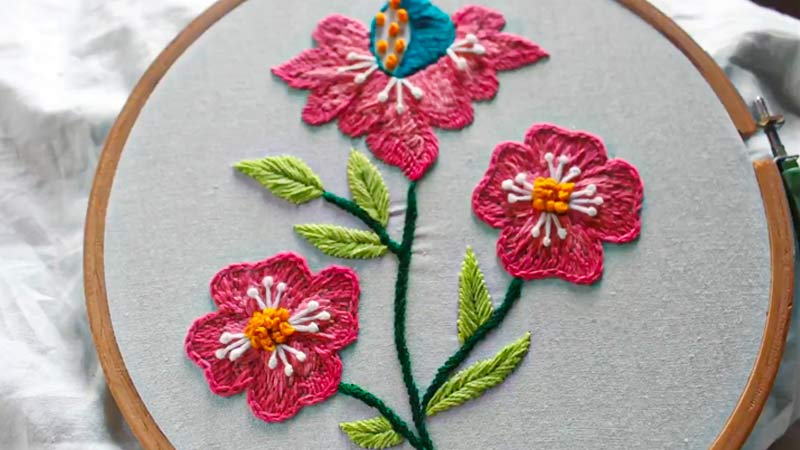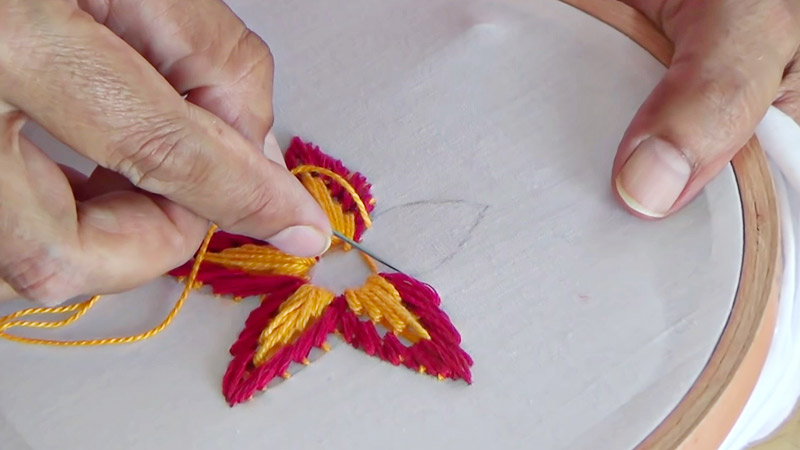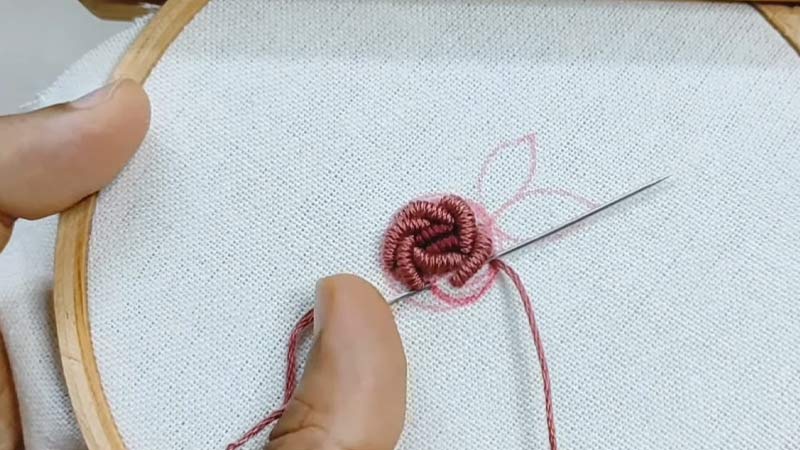Embarking on a hand embroidery project can be a delightful journey of creativity and craftsmanship. However, even the most seasoned embroiderers occasionally face a frustrating challenge: loose stitches.
The beauty of hand embroidery lies in the precision and detail of each carefully placed stitch, making loose embroidery a perplexing issue.
In this guide, we will answer ‘Why is my hand embroidery loose?’ and explore the common culprits that may be undermining your stitching finesse.
From thread tension to needle choice, understanding the factors at play is crucial for achieving the flawless, tight embroidery you envision.
So, if you’ve ever wondered why your hand embroidery isn’t quite as snug as you’d like it to be, join us as we delve into the intricacies of this art form and discover how to tighten up those loose stitches for a polished and professional finish.

Why Is My Hand Embroidery Loose?
Hand embroidery projects are filled with creativity, patience, and attention to detail. However, even the most experienced embroiderers encounter challenges with loose embroidery stitches. Let’s find out why this happens:
Understanding the Anatomy of a Stitch
Before diving into troubleshooting, it’s essential to understand the basic components of a stitch.
In hand embroidery, a stitch consists of a top thread (the thread visible on the front of the fabric) and a bottom thread (the thread on the back). The balance between these two threads determines the overall tension of your stitches.
Common Causes of Loose Stitches
Some common reasons why you face the embroidery loose stitches issue are:
Thread Tension
If your stitches are consistently loose, the tension of your thread may be too low. Adjust the tension on your embroidery hoop or frame to create a firmer foundation for your stitches.
Inconsistencies in tension can result in uneven stitches. Pay attention to maintaining a steady tension throughout your embroidery to achieve a uniform appearance.
Thread Type and Thickness
Using threads of different types or thicknesses can lead to uneven tension. Ensure that the threads you choose are compatible and complement each other in your embroidery project.
Low-quality threads may lack the strength needed for tight stitches. Invest in high-quality embroidery threads to enhance the durability and appearance of your work.
Needle Selection
Using the wrong needle size for your fabric and thread can result in loose stitches. Choose a needle that matches the weight of your fabric and the thickness of your thread for optimal results.
A dull or blunt needle can struggle to pierce the fabric cleanly, leading to loose and messy stitches. Regularly change your needles to maintain sharpness.
Stitching Techniques
Varying stitch lengths within your embroidery can create an uneven surface. Practice maintaining a consistent stitch length for a smoother and tighter appearance.
Pay attention to the direction of your stitches. Consistently stitching in the same direction can contribute to a neater and more uniform result.
How to Fix Loose Embroidery Stitches?

Embarking on an embroidery project only to find your stitches coming loose can be disheartening. Loose embroidery stitches can compromise the overall look and durability of your work.
However, fear not – you can salvage your project and prevent future mishaps with the right troubleshooting and solutions.
Here’s a comprehensive guide on how to fix embroidery coming loose.
Assess the Root Cause
Before diving into solutions, it’s crucial to identify why your embroidery stitches are coming loose. Common causes include improper tension, the wrong needle or thread, or inconsistencies in stitching techniques. Understanding the root cause will guide your corrective actions.
Tighten the Hoop or Frame
Adjust the tension on your embroidery hoop or frame if your stitches are consistently coming loose. A slightly tighter tension can help secure the stitches.
If you’re using a sewing machine for embroidery, ensure that the thread tension settings are appropriate for your project. Consult your machine’s manual for guidance on adjusting thread tension.
Optimize Thread Choices
Ensure all threads used in your project are of the same type and thickness. Mismatched threads can lead to tension issues and contribute to loose stitches.
High-quality embroidery threads are more resilient and less prone to breakage. Investing in reputable brands can significantly improve your embroidery’s overall durability and appearance.
Choose the Right Needle

The needle you use plays a crucial role in stitch integrity. Choose a needle size that matches the fabric weight. A larger needle suits heavier fabrics, while a smaller one works well for lighter materials.
A blunt needle can cause fabric distortion and loose stitches. Regularly change your needles to maintain sharpness and improve the overall quality of your embroidery.
Refine Stitching Techniques
Uneven stitch lengths can result in a bumpy surface and loose stitches. Focus on maintaining a uniform stitch length throughout your embroidery project for a smoother finish.
Consistently stitching in the same direction contributes to a neater appearance. Pay attention to the angle at which you insert your needle to ensure clean and tight stitches.
Secure Loose Ends Immediately
If you notice a loose stitch, address it promptly by re-threading the needle and securing the loose end. This prevents the entire embroidery from unraveling.
To reinforce the end of a thread, create a small knot or use a backstitch at the starting and ending points of each line of embroidery. This adds extra security to your stitches.
Employ Stabilizers for Delicate Fabrics
When working with delicate fabrics, use lightweight stabilizers or interfacing. This provides additional support and prevents the fabric from stretching, reducing the likelihood of loose stitches.
Delicate fabrics can be more susceptible to damage. Stitch gently, avoiding excessive tension, which can distort the fabric and lead to loose stitches.
Practice on Scrap Fabric
Before beginning your main embroidery project, test your chosen materials on a scrap piece of fabric. This allows you to identify and address any tension or stitching issues without compromising the integrity of your main piece.
If the test reveals loose stitches, adjust your technique or materials accordingly before proceeding with the main project. So, now you know how to fix loose embroidery threads!
What Is Hand Embroidery?

Hand embroidery, a timeless craft, involves the intricate art of decorating fabric using a needle and thread.
Across cultures and centuries, artisans have showcased their skills through delicate and detailed designs, creating a rich tapestry of traditions.
Basic Stitches and Techniques
Hand embroidery employs fundamental stitches such as the satin stitch, backstitch, chain stitch, and French knot. These stitches are skillfully combined to form many designs, ranging from simple floral patterns to complex scenes.
The craft’s versatility allows for using different fabrics, threads, and stitches to achieve various textures, colors, and effects.
Cultural and Historical Significance
Hand embroidery holds cultural and historical significance, with civilizations worldwide contributing to its diverse traditions.
Examples include traditional Japanese embroidery, featuring designs inspired by nature and spirituality, and Indian techniques like Kantha, Chikankari, and Zardozi, showcasing a rich textile heritage.
Stylistic Evolution
The craft has evolved stylistically over time, from the ornate styles of the Renaissance to the more minimalist and modern approaches of contemporary embroidery artists.
Whether expressing personal creativity or serving practical purposes, such as embellishing clothing, hand embroidery continues to adapt and thrive.
Tools and Materials
The process of hand embroidery involves basic tools such as a needle and embroidery hoop. The hoop helps maintain fabric tension, and the needle choice depends on the fabric and thread used.
Embroidery floss or thread in various colors allows for intricate combinations and shading.
Patterns and Design Creation
Embroidery enthusiasts often follow patterns or create their own designs. Various methods, including tracing, iron-on transfers, or water-soluble stabilizers, are employed to transfer patterns onto the fabric.
This initial step sets the stage for the following meticulous stitching, demanding patience, precision, and attention to detail.
Therapeutic Benefits
Beyond its artistic merits, hand embroidery offers therapeutic benefits. The repetitive nature of stitching provides a meditative experience, offering a sense of calm and focus.
The craft fosters a feeling of accomplishment as intricate designs gradually take shape through the careful interplay of needle and thread.
FAQs
Why are my hand embroidery stitches uneven?
Uneven hand embroidery stitches can result from various factors, such as inconsistent thread tension, improper needle size, or varying stitch lengths. To address this, ensure consistent tension, use an appropriate needle for your fabric, and practice maintaining uniform stitch lengths.
How do I fix loose tension in hand embroidery?
Adjust the tension on your embroidery hoop or frame to fix loose tension in hand embroidery. Experiment with slightly tighter tension settings and test on a scrap piece of fabric before starting your project to find the optimal balance.
What type of needle should I use for hand embroidery?
Choose a needle size that matches the weight and type of your fabric. Heavier fabrics require larger needles, while lighter fabrics need smaller ones.
Additionally, ensure your needles are sharp by changing them regularly to prevent loose stitches caused by blunt needles.
Can I use different thread types in the same embroidery project?
Using different thread types in the same project can lead to uneven tension and appearance. Sticking to threads of the same type and thickness is recommended for a cohesive and balanced result in your hand embroidery.
How can I prevent loose stitches when working with delicate fabrics?
When working with delicate fabrics, choose a fine needle and lightweight thread. Be gentle while stitching to avoid pulling or distorting the fabric, and use an embroidery hoop or stabilizer to provide additional support and maintain tension.
Conclusion
Mastering the art of hand embroidery involves creativity and a keen understanding of the technical aspects that contribute to the final result.
Loose stitches need not be a source of frustration; rather, they can serve as valuable lessons in the craftsmanship of this intricate art.
By addressing issues such as thread tension, needle selection, and stitching techniques, you can elevate the quality of your hand embroidery to new heights. Remember, practice and patience are key allies on your embroidery journey.
As you implement the insights gained from this exploration into the world of loose stitches, you’ll create beautiful, tight embroidery that reflects the skill and dedication you bring to each stitch.
So, embrace the challenge, refine your techniques, and let your hand embroidery projects flourish with the precision and elegance they deserve.
Leave a Reply